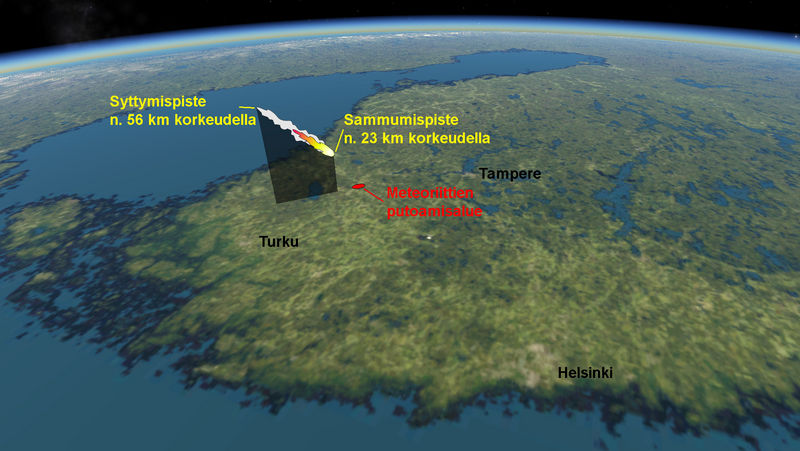
The flight route of the bright fireball that flew over Southern Finland on Wednesday 8th of May has been modelled. Esko Lyytinen, mathematician of URSA astronomical association and member of URSA Finnish Fireball Working Group, estimated that about 5kg of the fireball ended up on the earth's surface, in the southern part of Huittinen. There were over 300 sightings of the fireball reported in the URSA database.
The exact flight route estimation was based on the meteor camera pictures of URSA Finnish Fireball Working Group. Photographers of the fireball route were Johan Linden in Turku and Aki Taavitsainen in Mikkeli.
The cause of the fireball light phenomena was a meteoroid that passed through the atmosphere. Based on the simulation, the mass of the meteoroid was about 50 kilograms, and it's diameter was about 30 centimeters. It arrived in the atmosphere at a 43 degree angle.
The speed of the object was about 23 kilometers per second when it arrived the atmosphere. It ignited into a glowing fireball near Mynämäki at the height of 60 kilometers, from where it travelled into north-east. After crossing Lake Pyhäjärvi, the fireball flamed out northeast of Säkylä, at an altitude of about 23 kilometers.
It's usually very challenging to find meteors on the ground in Finland. No pieces of the fireball have been found yet. The impact zone is about 10 kilometers to the south from the center of the town of Huittinen.
Even though the fireball was impressive, it was still about 200 000 times smaller that the one that was seen over Russia, Tseljabinski on February 15th. The object that impacted Tseljabinski was originally 17-meter diameter asteroid, and it's mass was about 10 million kilograms.
Comment: Well, the Russian comet fragment didn't impact Tseljabinski, so it's difficult to take their size estimate of this one at face value. Based on our experience of noticing observatories generally downplay the size of objects, we think it's safe to say that this space rock was larger than 30 cm in diameter...
Hundred Tonnes of Shooting Star Material
The earth's atmosphere is impacted daily by hundreds of tonnes of small objects from space, which nearly all get destroyed, when they pass through the atmosphere. Small fragments of that material will heat up during their fall and start to glow. As they fall, they will cause bright flashes in the sky that are called shooting stars.
If the object that ends in the atmosphere is large enough that its magnitude is brighter than any star or planet, then it is classed as a fireball. Shooting stars are called fireballs if it their magnitude is brighter that the planet Venus. Smaller fireballs usually burn out in the atmosphere and there are several reports of them in Finland throughout the year. Most significant fireballs are considered for example those objects, which end up on the earth's surface as a half kilogram (at least) meteorite.
The phenomenon of 8th May was a significant fireball that was part of the 5 kilogram meteor and the supersonic explosion it caused.



Comment: Ah, the normalcy bias: "Earth has always been impacted by hundreds of tonnes of small objects from space, so the spectacular fireballs phenomenon everyone the world over has noticed in the past few years has always been so, except that now, people suddenly notice them more..."
Does that sound credible to you?
Note the casual remark at the very end, after giving us 'the dry facts' about fireballs: Say what?!
That is rare! Well, it was rare. It's more normal now! But only because something wicked this way comes...